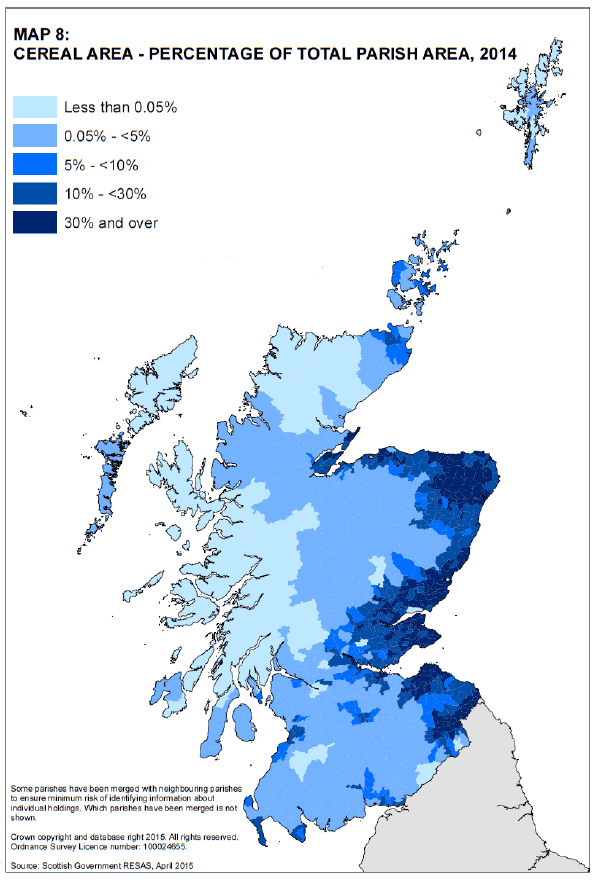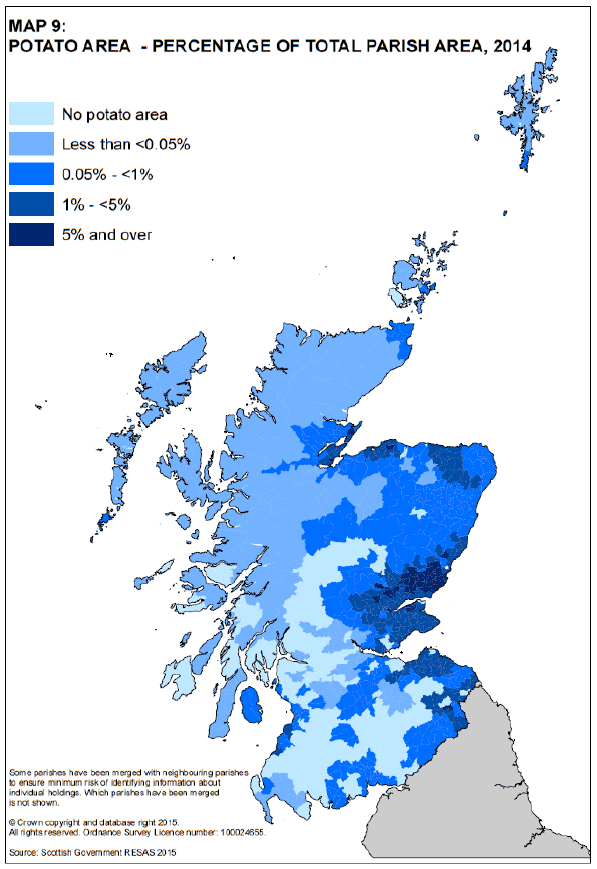Economic Report on Scottish Agriculture 2015
Economic Report on Scottish Agriculture 2015 presenting an overall picture of Scottish agriculture using data from the various agricultural surveys that RESAS manage.
4. Crops
4.1 Overview (Table C2)
In 2014 crops accounted for almost ten per cent of agricultural land; barley accounted for 327,000 hectares, wheat 109,000 hectares, oats 25,000 hectares, oilseed rape 37,100 hectares, potatoes 28,500 hectares, stock-feeding crops 22,000 hectares, vegetables for human consumption 16,300 hectares, and fruit (grown in the open) 760 hectares.
Chart 4.1 shows production trends of various crops, presented as indices of tonnage.
The most striking trend is the increase in production of raspberries and strawberries, which has nearly doubled over the past ten years (even with the fall in 2012). This is mostly due to increases in the area and yields of strawberries, with the proliferation of strawberries grown under cover having a big impact.
After steady increases between 2004 and 2010, the production of vegetables decreased between 2011 and 2012, probably due to the poor weather, with a recovery in 2014 to the highest levels seen in the ten years.
Chart 4.1: Production indices for crops 2004 to 2014 (2004 = 100)
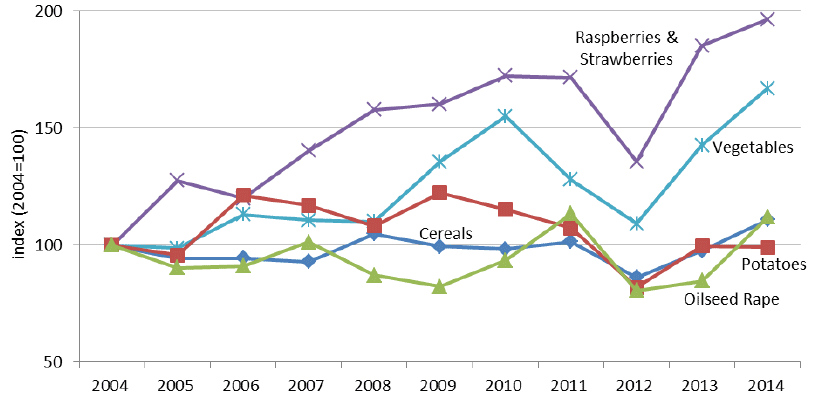
The production of potatoes increased by 300,000 tonnes (27 per cent) between 2005 and 2006 and generally remained higher for most years compared to pre-2006 levels. However, as with other crops, poor yields were obtained in 2012, with production falling right back to below 2004 levels. The recovering in 2013 only brought production back to levels similar to those of 2003 with 2014 seeing little change.
There has been little variation in cereal production over the last ten years, which has ranged from 2.51 million tonnes in 2012 to 3.22 million tonnes in 2014. The 2014 harvest was 316,000 tonnes higher (11 per cent) than the 2004 harvest.
The production of oilseed rape, including that grown for industrial purposes, was 15,700 tonnes higher (12 per cent) in 2014 than in 2004. Over the past ten years production levels have been quite varied, ranging between 106,000 tonnes in 2012 and 150,000 tonnes in 2011.
4.1.1 Distribution of crops by region (Table C4)
Chart 2.1 shows the regional distribution of use of agricultural land. In more detail, chart 4.2 shows that Grampian accounted for the largest proportion of barley (41 per cent) and oilseed crops (32 per cent). Tayside had the largest area of wheat (24,500 hectares or 22 per cent of the national total). Map 8 shows the prevalence of cereals on the east coast, with high rates in East Lothian, Fife, Angus and Aberdeenshire.
Crops for stock-feeding were more likely to be grown in areas with high numbers of livestock such as Grampian (4,500 hectares) and Scottish Borders (3,700 hectares), which each represented around a fifth of the Scotland total.
Chart 4.2: Distribution of crop types by sub-region, June 2014
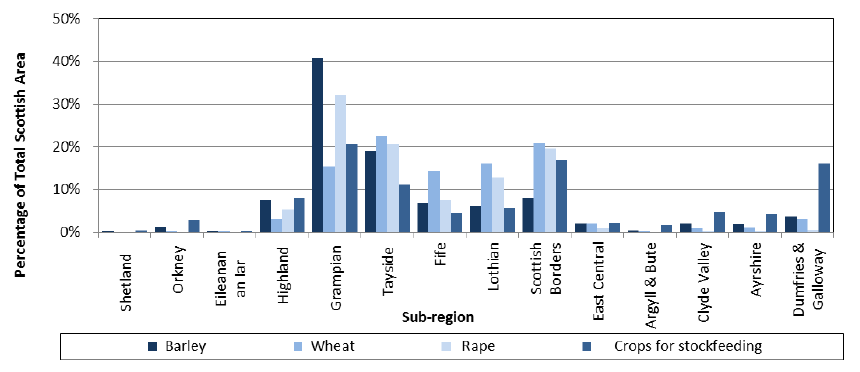
Chart 4.3: Distribution of potatoes, soft fruit and vegetables by sub-region, June 2014
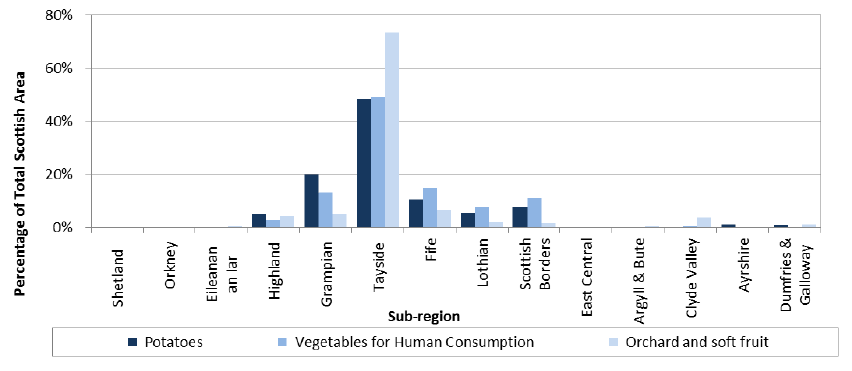
Regarding other crops, chart 4.3 shows that Tayside had 74 per cent (560 hectares) of the land used for orchard and soft fruit in Scotland. Tayside also accounted for
nearly half (49 per cent or 8,000 hectares) of the land used in Scotland to grow vegetables for human consumption, and, as illustrated in Map 9, also accounted for nearly half (49 per cent or 13,800 hectares) of the area used for growing potatoes. Elsewhere in the east, Grampian, Fife, Scottish Borders and Lothian are the other areas that contributed greatly to the production of other crops.
4.1.2 Income from crops (Tables A1, A2, A3, A4)
Crops account for about 30 per cent of total output from farming. Since 2004 the total output value of crops, excluding related subsidies, has increased by £366 million (72 per cent) to £870 million in 2014. There has been a general increasing trend in the value of horticulture (up £148 million or 117 per cent) along with oilseed rape and other farm crops (up £16 million or 58 per cent), with a slight decrease seen since 2012. Trends in cereals and potatoes have also been upwards but have fluctuated more over time.
Chart 4.4: Output value of crops (excluding subsidies) 2004 to 2014
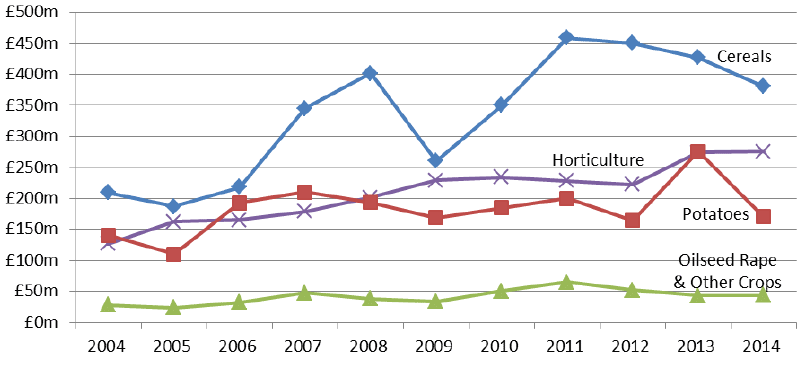
Between 2004 and 2014 the value of cereals increased by £171 million (82 per cent), however this trend includes large increases of £184 million between 2006 and 2008 and £198 million between 2009 and 2011, as well as a large decrease of £141 million between 2008 and 2009. These trends largely reflect market price movements, as production levels have not varied to this extent.
The value of potatoes increased by £30 million (21 per cent) between 2004 and 2014, this trend included a large increase of £111 million between 2012 and 2013, when production and market prices of potatoes both increased, though this was cancelled out in 2014.
Over the shorter term, provisional estimates for 2014 suggest that the output value of crops decreased by £150 million (15 per cent) from 2013. The output value of potatoes and cereals decreased over the last year by £105 million (38 per cent) and £46 million (11 per cent) respectively. Oilseed rape showed a nine per cent increase, other farm crops fell 21 per cent, while horticulture remained relatively unchanged.
Tables A2(i) to A2(iii) provide information on area, yield and production of a selection of crops. These production figures form the basis of TIFF crop valuations. It should be noted however that production is valued at the point it is used or sold off the farm,
so there can be differences between calendar year production and output volumes. The TIFF calculation also includes end year stock valuations.
Statistics on crop areas come from the June Agricultural Census. A detailed description of area trends between 2004 and 2014 is available in the Statistical Publication 'Results From the June 2014 Scottish Agricultural Census', available at www.gov.scot/stats/bulletins/01117
A detailed description of statistics on area, yield and production of cereals and oilseed rape was published in December 2014 in the publication 'Final Estimate of Cereal and Oilseed Rape Harvest 2014', available at www.gov.scot/Publications/2014/12/2462
Contact
Email: Agricultural Statistics
There is a problem
Thanks for your feedback
